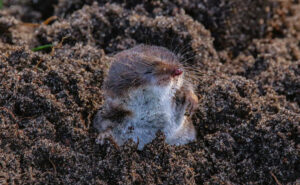
Moles vs voles! It’s a battle between two pesky critters that can make their homes in your backyard. Moles and voles have similar names, and their behaviors sometimes match up too. There are over 400 mammal species in the USA, so it’s no wonder many people need a little extra guidance.
But what is the difference between these two creatures? It’s worth knowing a thing or two about each creature to help you learn prevention measures. Knowing what to look out for will allow you to keep your yard safe from moles and voles alike.
Want to learn more about how these creatures differ and what to do if you spot one? There’s no need to keep digging; you’re already in the right place! Read on to find out more about the differences.
What Do Moles Look Like?
Moles are small furry creatures about four to seven inches long. They are dark brown almost all over, with two notable features: they have paddle-shaped claws used for digging and long pink noses. You won’t see a mole’s eyes since they’re small and generally hidden in fur.
You’ll rarely see moles in the flesh. They spend almost their entire lives underground, only coming to the surface occasionally when they need to collect leaves and twigs for nesting material.
What Do Voles Look Like?
Although they may look similar to moles at first glance, voles are very different to moles. They are slightly larger than moles, measuring between five and eight inches. Their fur is a dark gray or brown, a similar color to a mole’s.
Moles look a little like mice, with shiny black eyes and short tails. They spend more time above ground than moles and may be seen quickly darting around your lawn as they go hunting for food.
Mole vs Vole Tunnels
Both moles and voles dig tunnels. But both dig in quite different ways.
Mole tunnels can be quite elaborate, stretching out for many feet underground. Moles dig at a rate of about 18 feet an hour, and they can live in the same tunnel network for generations before moving on.
These tunnel networks normally sit about a foot underground, although some temporary tunnels will be built closer to the surface. The tunnel networks can contain special chambers for raising young and storing food.
Voles move in after moles have gone. But they expand the tunnel network for their own uses, creating exit holes throughout the tunnel. These exit holes are smaller than molehills and can pop up all over your lawn, as voles live in large colonies.
Moles vs Voles
Moles and voles have a lot of differences, but there’s one similarity in the moles vs voles battle: they can cause plenty of damage to your lawn. If you spot signs of their presence, it’s time to call in the experts.
If you’re wondering how to catch moles, we can help. We offer a wide range of pest control services. Contact us today to find out more about how we can help.







No comment yet, add your voice below!